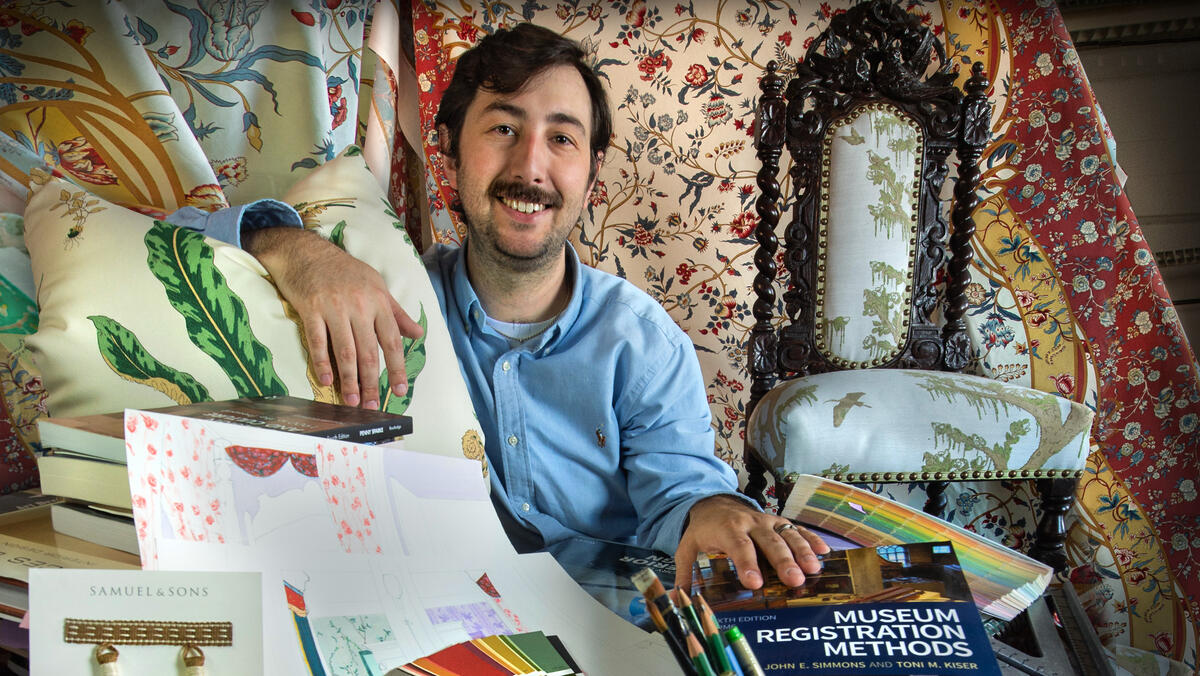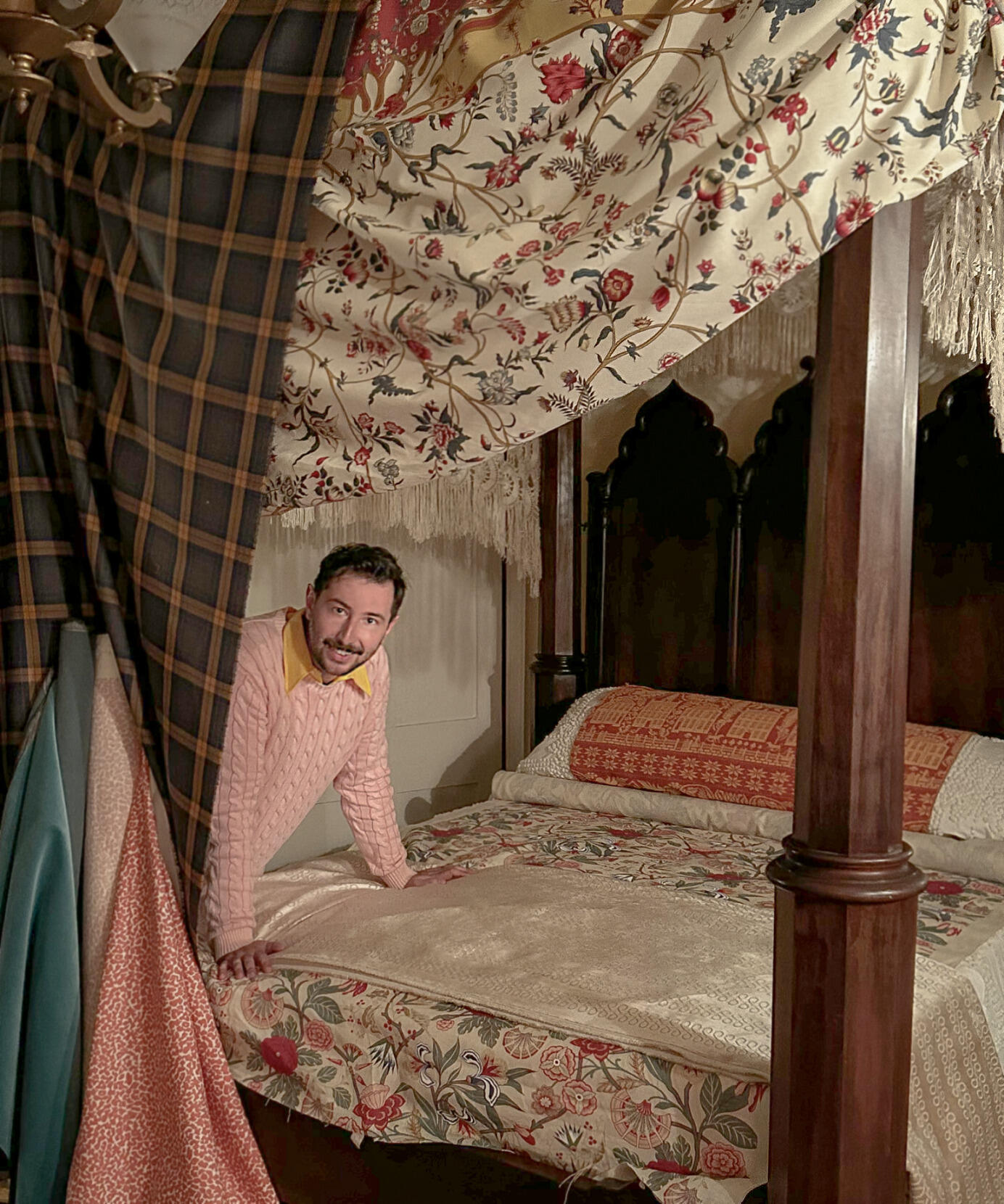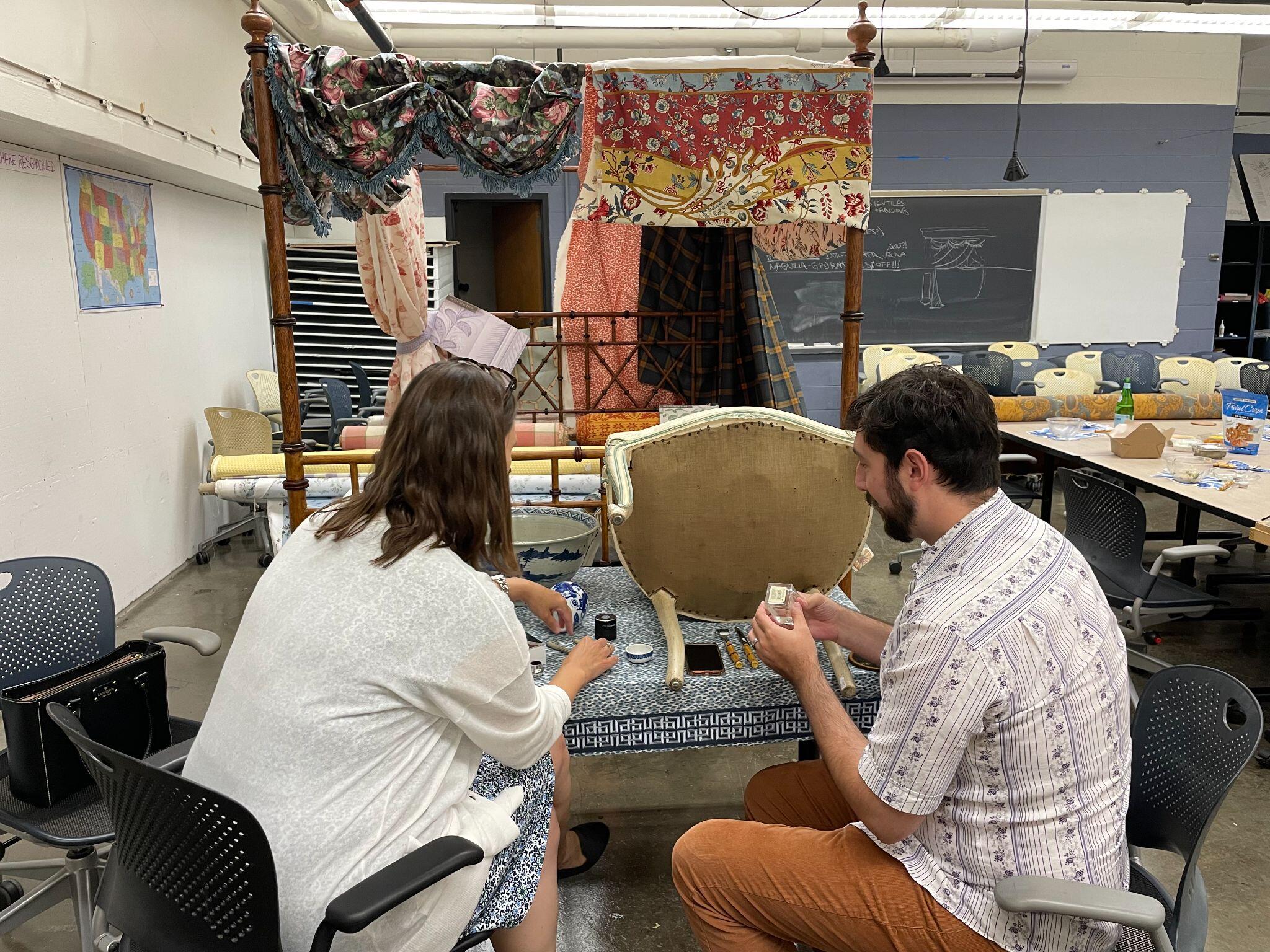
April 10, 2024
Interior design student finds the thread that connects his work and his studies
Experienced upholsterer Andrew Grider uses research grants to help the Hill House Museum in Portsmouth, Virginia, tell its story.
Share this story
About Every Ram’s a Researcher: As part of Research Weeks 2024, this series highlights the ways that undergrads at VCU, no matter their major, get involved with meaningful research that enriches their college experience.
Andrew Grider was a traditional upholsterer by trade prior to his service in the Navy and then slowly resumed his passions. He worked on many historic pieces, sometimes collaborating with clients in their homes as well as with textile companies.
As an adult learner who later enrolled in Virginia Commonwealth University, Grider wanted to pursue research to get the most out of his undergraduate journey – and to help him stand out. Last spring, the School of the Arts undergraduate, who is majoring in interior design and minoring in craft and material studies, brought his work experience and his academic passion into special focus.
“I just prefer the craftsmanship of years gone by because, also being a craftsperson, there’s an appreciation to what they do in traditional methods,” Grider said. “I live in a historic neighborhood in Virginia, so there’s a historic tie to where I live and what I do for work. So it’s just like a culmination of all that.”
Grider’s research was for the Hill House Museum in Portsmouth, a historic home furnished with items from the 19th and 20th centuries. The Hill sisters who owned the home established the Princess Anne Humane Society and the Princess Anne Garden Club, and Grider’s initial plan was to restore a parlor set of two chairs and a settee.
“It transpired to something a lot bigger than what it actually started out to be,” he said.

Grider studied and researched how the museum’s furnishings plan should be executed for two bedrooms on the third floor. He focused on the interior narrative reflecting the Hill sisters, who were the home’s last residents before its transition into a house museum.
Grider’s project used several grants, one of which even allowed him to take a sabbatical from VCU to focus on his research. An initial grant came from VCU’s Undergraduate Research Opportunities Program, which provided a cash stipend of $1,500. Another grant was from the Pennsylvania-based Decorative Arts Trust, which helped Grider cover travel expenses. And, he received a third from the International Furnishings and Design Association specifically for recreating the missing testers on the 19th-century bedsteads to allow for bed hangings and a canopy ceiling.
Grider praised VCU faculty mentor Sara Reed, an assistant professor of interior design, for her help in securing the grants. They met during her History of Interior Environments course, and Reed saw how Grider was a self-starter with a wealth of knowledge from his previous work.
“He used every asset I felt like that he was offered, and I think that that’s something that I hope other students take away,” Reed said. “It’s like the curiosity he had. He took the next step, he took the leap of faith – it was probably a bigger leap than he realized.”
As part of his research, Grider traveled to New Orleans, a cultural hub for fashions of the South back in the day, as well as down the East Coast, from Portsmouth, New Hampshire, back to Portsmouth, Virginia, and stopped at more than 40 historical homes and museums. He said the Hill sisters participated in garden shows in New York City and would have been regularly exposed to cultural influences along the coast. The trip also allowed him to see how other house museums display and preserve artifacts.
“I had a revelation when I was in Newport, Rhode Island, that a lot of the last heirs for these estates were women, and they then were the ones who foresaw their house being preserved as a house museum. It led me down this path of, ‘Well, what other things were women doing at the time?’” Grider said.
“So I was also looking at like an alternative narrative to the Hill House, [which] is also the dialog of women in design in the second quarter of the 20th century and how it related to what was shown, who were the tastemakers, what were the styles going on at this time and how the textiles and the way it’s put together relate to all of that.”
Grider answered some quick additional questions about his experience as an undergraduate researcher.
What led you to this research?
It was really an interest in helping the museum tell its story more effectively, like with the narrative through soft furnishings. But then there’s also a need. Since the museum doesn’t have an actual curatorial staff, there’s no one with a design background or conservation background either – it’s volunteer-based. It’s also the only house museum in Portsmouth, so it’s also giving back to where I live locally.
For a project that we had to do for our History of Interior Environments course, I was working with the curation specialist at the Virginia Museum of Fine Arts to look closely at and handle the Rhulman chair, one of the pieces they had on display. There’s much more academia related to interior design. There’s a lot of culture – the way that things are laid out that can tell a story about the people and place, who lived there, what they did, who their family was. My interests really grew because I’m kind of going down that path of the historic side of interiors.
Beyond the research itself, what skills or connections have you developed through this project?
I was able to talk with and get a lot of feedback from museum professionals. And when I got back from my travels down the East Coast, the Interior Design Department let me use one of the studios here, so I was able to spread out all the materials that I had collected. I came back with a lot of fabric that was donated for the project. Anthony Baratta, who was the first designer in residence at Colonial Williamsburg, played a monumental role with a lot of that and helped out because [the project] was mostly based on donation. The Williamsburg brand also has been in contact with me and shared my progress since I’m using one of their products from a collaboration with Schumacher for a border on one of the beddings.

What did you enjoy most about this project?
I like that it challenged me. I also had several presentations with the interior design department here. There was feedback, which I really liked because it was all coming together for the big presentation to the board members of the Hill House – they were the people who were going to say yes or no, and I had to be very specific. I scaled down the presentation to 37 minutes, but I did end up staying another 5½ hours because they wanted to talk more about every little thing because they were so enthralled about it.
And my favorite thing was really going behind the scenes of a lot of house museums in New England and so forth that a lot of people don’t really see. It tells me about how America is.
What advice do you have for other undergrads on how to get involved in research?
Stay curious about things, first and foremost. And it’s really good to find a faculty member in your department whom you can really connect with. Faculty are able to network or expand your network.
I think every major [has research opportunities]. It’s just not in the curriculum – just stay curious and ask a lot of questions. Because asking more questions, getting answers, you’ll get more questions and more rabbit holes.
Subscribe to VCU News
Subscribe to VCU News at newsletter.vcu.edu and receive a selection of stories, videos, photos, news clips and event listings in your inbox.















